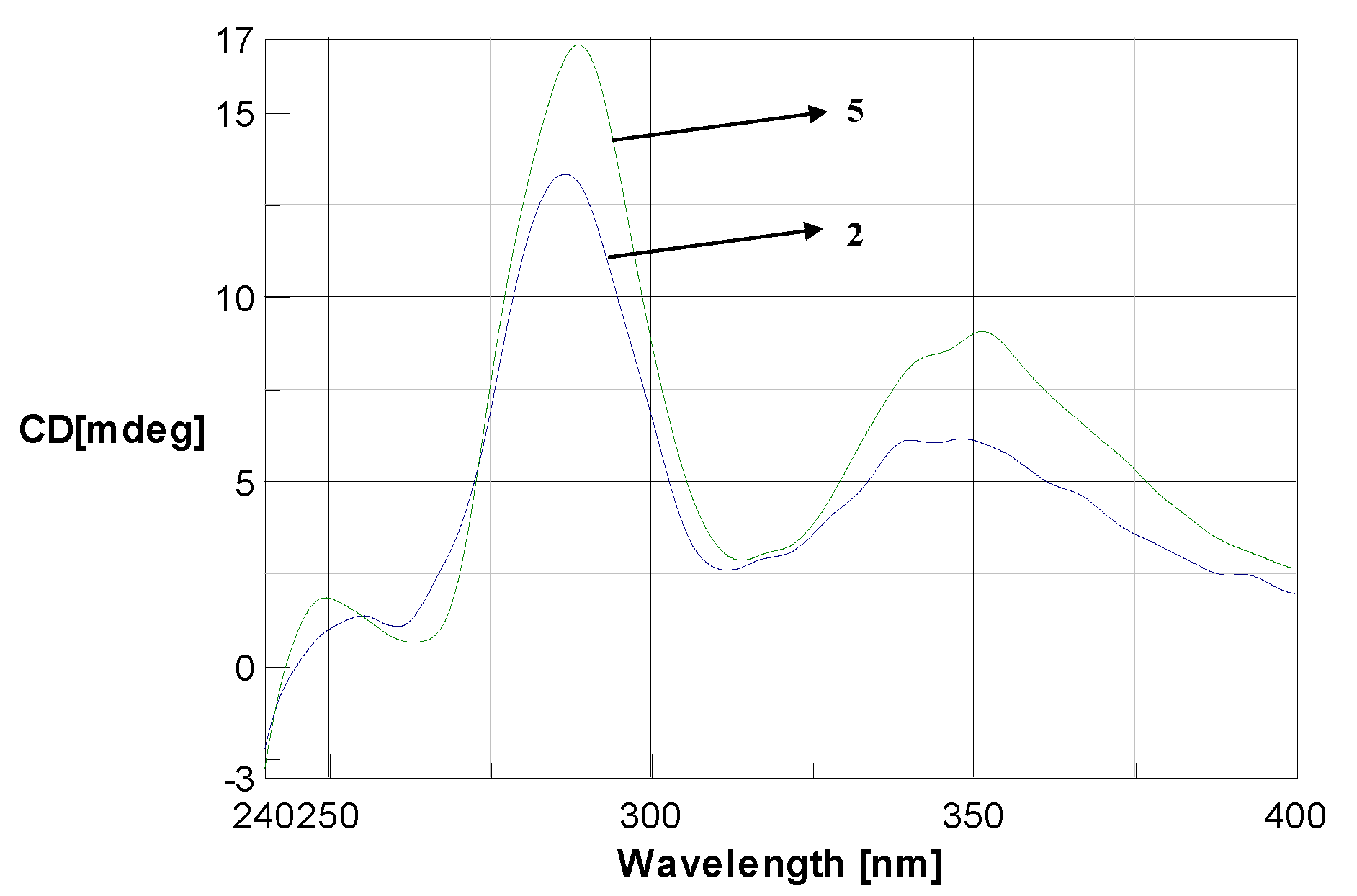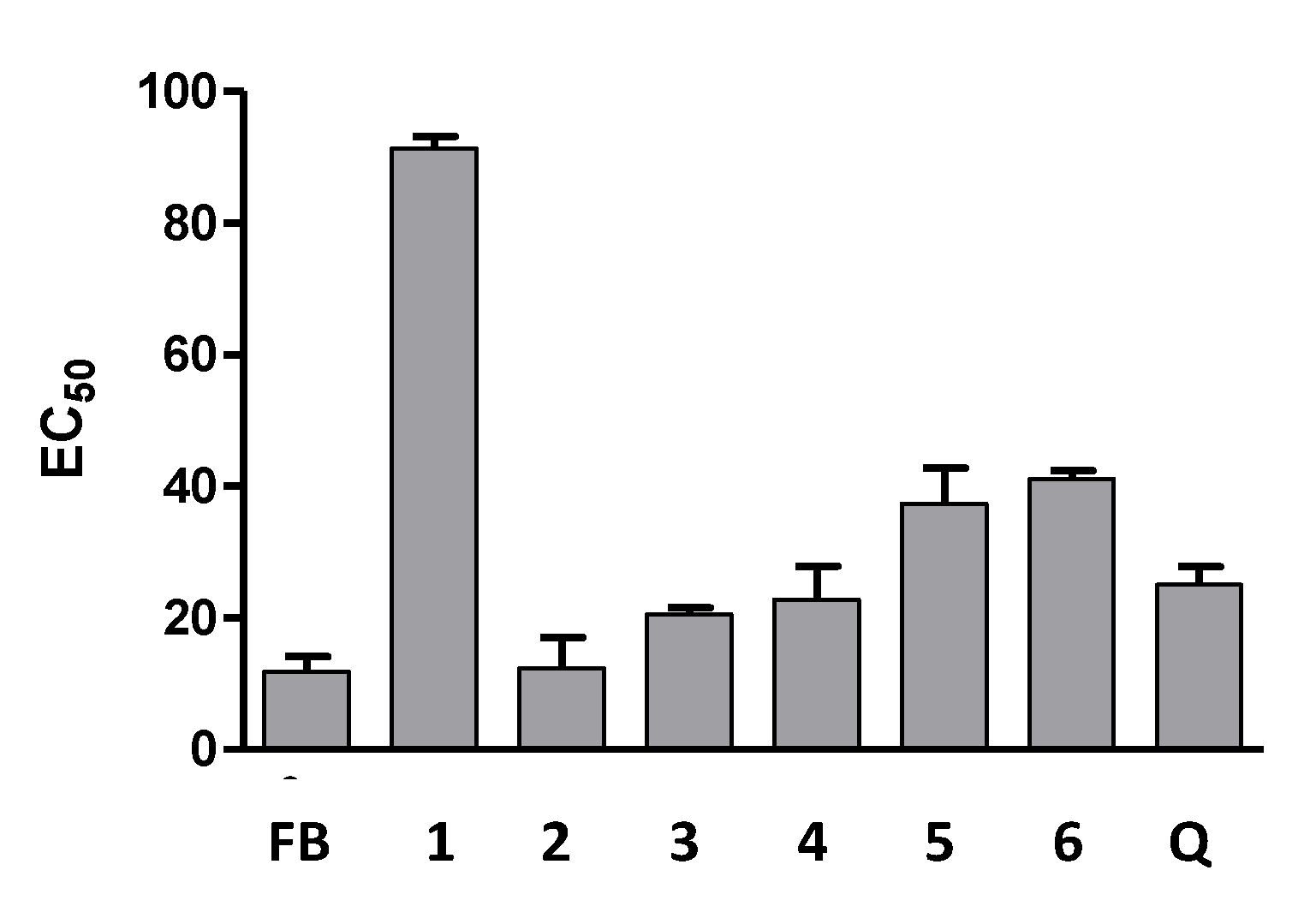Low-Density Lipoprotein (LDL)-Antioxidant Biflavonoids from Garcinia madruno
Abstract
:1. Introduction
2. Results and Discussion
2.1. Structure Elucidation

| 1H δ (J in Hz) | 13C | HMBC | ||||
|---|---|---|---|---|---|---|
| 5a | 5b | 5a | 5a | |||
| 2 | 5.76 d (12.0) | 5.76 d** | 82.87 d | C-1' | ||
| 3 | 4.81 * | 5.33 d (12.0) | 51.21 d | C-1', C-7'', C-9'' | ||
| 4 | 197.36 s | |||||
| 5 | 165.84 s | |||||
| 6 | 5.96 brs | 5.96 brs | 99.61 d | C-8, C-10 | ||
| 7 | 164.92 s | |||||
| 8 | 5.96 brs | 5.96 brs | 96.65 d | C-10 | ||
| 9 | 168.51 s | |||||
| 10 | 103.65 s | |||||
| 1' | 130.55 s | |||||
| 2' | 7.05 d (8.8) | 7.11 d (8.0) | 129.33 d | C-2, C-4', C-6' | ||
| 3' | 6.35 d (8.4) | 6.35 d (8.4) | 115.51 d | C-1', C-5' | ||
| 4' | 158.53 s | |||||
| 5' | 6.35 d (8.4) | 6.35 d (8.4) | 115.51 d | C-1', C-3' | ||
| 6' | 7.05 d (8.8) | 7.11 d (8.0) | 129.33 d | C-2, C-2', C-4' | ||
| 2'' | 166.28 s | |||||
| 3'' | 6.41 s | 6.52 s | 104.49 d | C-1''' | ||
| 4'' | 184.04 s | |||||
| 5'' | 162.75 s | |||||
| 6'' | 6.66 s | 6.56 s | 100.01 d | C-8'', C-10'' | ||
| 7'' | 161.62 s | |||||
| 8'' | 104.94 s | |||||
| 9'' | 156.80 s | |||||
| 10'' | 106.74 s | |||||
| 1''' | 123.09 s | |||||
| 2''' | 7.31 brs | 7.26 brs | 114.38 d | C-6''' | ||
| 3''' | 146.92 s | |||||
| 4''' | 151.35 s | |||||
| 5''' | 6.88 d (8.4) | 6.61 d (8.4) | 116.97 d | C-3''' | ||
| 6''' | 7.27 brd (8.0) | 7.10 brd** | 120.89 d | C-2'', C-2''', C-4''' | ||
| 1'''' | 5.24 d (7.6) | 5.17 d (8.0) | 101.32 d | C-7'' | ||
| 2'''' | 3.34 m | 3.34 m** | 75.24 d | |||
| 3'''' | 3.38 dd (9.2, 8.8) | 3.38 m** | 78.22 d | |||
| 4'''' | 3.82 m | 3.82 m** | 75.73 d | |||
| 5'''' | 3.60 ddd (11.2, 6.2, 2.3) | 3.60 m** | 71.36 d | |||
| 6''''a | 4.27 dd (12.0, 2.3) | 4.27 m** | 64.54 t | OCOMe | ||
| 6''''b | 4.13 dd (12.0, 6.4) | 4.13 m** | ||||
| OCOMe | 172.75 s | |||||
| Me | 1.95 s | 2.03 s | 20.77 q | OCOMe | ||

2.2. Biological Activity

3. Experimental
3.1. General Experimental Procedures
3.2. Plant Material
3.3. Extraction and Isolation
3.4. 7''-O-(6''''-acetyl)Glucoside of Morelloflavone (5)
 + 155 (c 0.10, MeOH); CD (5.0 × 10−5 M)
+ 155 (c 0.10, MeOH); CD (5.0 × 10−5 M)  : [θ]288 +67,394, [θ]351 +36,263 (MeOH); UV λ (nm): 332, 292, 209, MeOHmax; IR (KBr) νmax cm−1: 3,168, 1,648, 1,536, 1,316; 1H-NMR and 13C-NMR see Table 1; HR ESIMS m/z 761.1720 [M+H]+ (calcd for C38H32O17, 761.1718).
: [θ]288 +67,394, [θ]351 +36,263 (MeOH); UV λ (nm): 332, 292, 209, MeOHmax; IR (KBr) νmax cm−1: 3,168, 1,648, 1,536, 1,316; 1H-NMR and 13C-NMR see Table 1; HR ESIMS m/z 761.1720 [M+H]+ (calcd for C38H32O17, 761.1718).3.5. Inhibition of LDL Oxidation
3.5.1. Human LDL Isolation
3.5.2. TBARS Determination
4. Conclusions
Acknowledgments
Conflicts of Interest
References
- Rivero, J.A.; Brunner, B.R. Árboles frutales exóticos y poco conocidos en Puerto Rico; La Editorial Universidad de Puerto Rico: San Juan, Puerto Rico, 2006; pp. 71–73. [Google Scholar]
- Suffredini, I.B.; Paciencia, L.B.; Nepomuceno, D.C.; Younes, R.N.; Varella, A.D. Antibacterial and cytotoxic activity of Brazilian plant extracts — Clusiaceae. Mem Inst Oswaldo Cruz. 2006, 101, 287–290. [Google Scholar]
- Baggett, S.; Protiva, P.; Mazzola, E.P.; Yang, H.; Ressler, E.T.; Basile, M.J.; Weinstein, I.B.; Kennelly, E.J. Bioactive benzophenones from Garcinia xanthochymus fruits. J. Nat. Prod. 2005, 68, 354–360. [Google Scholar] [CrossRef]
- Deachathai, S.; Mahabusarakam, W.; Phongpaichit, S.; Taylor, W.C. Phenolic compounds from the fruit of Garcinia dulcis. Phytochemistry 2005, 66, 2368–2375. [Google Scholar] [CrossRef]
- Lin, Y.M.; Flavin, M.T.; Schure, R.; Chen, F.C.; Sidwell, R.; Barnard, D.L.; Huffman, J.H.; Kern, E.R. Antiviral activities of biflavonoids. Planta Med. 1999, 65, 120–125. [Google Scholar] [CrossRef]
- Mackeen, M.M.; Ali, A.M.; Abdullah, M.A.; Nasir, R.M.; Mat, N.B.; Razak, A.R.; Kawazu, K. Antinematodal activity of some Malaysian plant extracts against the Pine Wood nematode Bursaphelenchus xylophilus. Pest Sci. 1997, 51, 165–170. [Google Scholar] [CrossRef]
- Mackeen, M.M.; Ali, A.M.; Lajis, N.H.; Kawazu, K.; Hassan, Z.; Amran, M.; Habsah, M.; Mooi, L.Y.; Mohamed, S.M. Antimicrobial, Antioxidant, Antitumour-promoting and cytotoxic activities of different plant part extracts of Garcinia atroviridis Griff. Ex T. Anders. J. Ethnopharmacol. 2000, 72, 395–402. [Google Scholar] [CrossRef]
- Mahabusarakam, W.; Wiriyachitra, P.; Phongpaichit, S. Antimicrobial activities of chemical constituents from Garcinia mangostana Linn. J. Sci. Soc. Thailand 1986, 12, 239–242. [Google Scholar]
- Tona, L.; Cimanga, R.K.; Mesia, K.; Musuamba, C.T.; De Bruyne, T.; Apers, S.; Hernans, N.; van Miert, S.; Pieters, L.; Totté, J.; et al. In vitro antiplasmodial activity of extracts and fractions from seven medicinal plants used in the Democratic Republic of Congo. J. Ethnopharmacol. 2004, 93, 27–32. [Google Scholar] [CrossRef]
- Abe, F.; Nagafuji, S.; Yamauchi, T.; Okabe, H.; Maki, J.; Higo, H.; Akahane, H.; Aguilar, A.; Jiménez-Estrada, M.; Reyes-Chilpa, R. Trypanocidal constituents in plants 1. Evaluation of some mexican plants for their trypanocidal activity and active constituents in Guaco, Roots of Aristolochia taliscana. Biol. Pharm. Bull. 2002, 25, 1188–1191. [Google Scholar]
- Cao, S.G.; Wu, X.H.; Sim, K.Y.; Tan, B.K.H.; Pereira, J.T.; Wong, W.H.; Hew, N.F.; Goh, S.H. Cytotoxic caged tetraprenylated xanthonoids from Garcinia gaudichaudii (Guttiferae). Tetrahedron Lett. 1998, 39, 3353–3356. [Google Scholar]
- Lin, Y.M.; Anderson, H.; Flavin, M.T.; Pai, Y.H. In vitro anti-HIV activity of biflavonoids isolated from Rhus succedanea and Garcinia multiflora. J. Nat. Prod. 1997, 60, 884–888. [Google Scholar] [CrossRef]
- Parveen, M.; Ilyas, M.; Mushfiq, M.; Basudan, O.A.; Muhaisen, H.M.N. A new biflavonoid from leaves of Garcinia nervosa. Nat. Prod. Res. 2004, 18, 269–275. [Google Scholar] [CrossRef]
- Osorio, E.; Montoya, G.; Bastida, J. Caracterización fitoquímica de una fracción de biflavonoides de Garcinia madruno: Su inhibición de la oxidación de LDL humana y su mecanismo de estabilización de especies radicalarias. Vitae 2009, 16, 369–377. [Google Scholar]
- Li, X.C.; Joshi, A.S.; Tan, B.; ElSohly, H.N.; Walker, L.A.; Zjawiony, J.K.; Ferreira, D. Absolute configuration, conformation, and chiral properties of flavanone-(3→8'')-flavone biflavonoids from Rheedia acuminata. Tetrahedron 2002, 58, 8709–8717. [Google Scholar] [CrossRef]
- Han, Q.B.; Lee, S.F.; Qiao, C.F.; He, Z.D.; Song, J.Z.; Sun, H.D.; Xu, H.X. Complete NMR assignments of the antibacterial biflavonoid GB1 from Garcinia kola. Chem. Pharm. Bull. 2005, 53, 1034–1036. [Google Scholar] [CrossRef]
- Ferrari, J.; Terreaux, C.; Kurtán, T.; Szikszai-Kiss, A.; Antus, S.; Msonthi, J.D.; Hostettmann, K. Isolation and on-Line LC/CD analysis of 3,8'-linked biflavonoids from Gnidia involucrata. Helv. Chim. Acta 2003, 86, 2768–2778. [Google Scholar] [CrossRef]
- Biloa, B.; Ndjoko-Ioset, K.; Hertlein-Amslinger, B.; Meli, A.; Nkengfack, A.E.; Wolfender, J.L.; Hostettmann, K.; Bringmann, G. Preussianone, a new flavanone-chromone biflavonoid from Garcinia preussii Engl. Molecules 2012, 17, 6114–6125. [Google Scholar] [CrossRef]
- Konoshima, M.; Ikeshiro, Y. Fukugiside, the first biflavonoid glycoside from Garcinia spicata hook. f. Tetrahedron Lett. 1970, 11, 1717–1720. [Google Scholar] [CrossRef]
- Pauli, G.F. Higher order and substituent chemical shift effects in the proton NMR of glycosides. J. Nat. Prod. 2000, 63, 834–838. [Google Scholar] [CrossRef]
- Švehlíková, V.; Bennett, R.N.; Mellon, F.A.; Needs, P.W.; Piacente, S.; Kroon, P.A.; Bao, Y. Isolation, identification and stability of acylated derivatives of apigenin 7-O-glucoside from chamomile (Chamomilla recutita [L.] Rauschert). Phytochemistry 2004, 65, 2323–2332. [Google Scholar] [CrossRef]
- Markham, K.R.; Geiger, H. The Flavonoids-Advances in Research since 1986; Harborne, J.B., Ed.; Chapman and Hall: London, UK, 1994; pp. 441–473. [Google Scholar]
- Masuda, T.; Yamashita, D.; Takeda, Y.; Yonemori, S. Screening for tyrosinase inhibitors among extracts of Seashore plants and identification of potent inhibitors from Garcinia subelliptica. Biosci. Biotechnol. Biochem. 2005, 69, 197–201. [Google Scholar] [CrossRef]
- Markham, K.R.; Sheppard, C.; Geiger, H. 13C NMR studies of some naturally occurring amentoflavone and hinokiflavone biflavonoids. Phytochemistry 1987, 26, 3335–3337. [Google Scholar] [CrossRef]
- Fonseca, F.N.; Ferreira, A.J.S.; Sartorelli, P.; Lopes, N.P.; Floh, E.I.S.; Handro, W.; Kato, M.J. Phenylpropanoid derivatives and biflavones at different stages of differentiation and development of Araucaria angustifolia. Phytochemistry 2000, 55, 575–580. [Google Scholar] [CrossRef]
- Herbin, G.A.; Jackson, B.; Locksley, H.D.; Scheinmann, F.; Wolstenholme, W.A. The biflavonoids of Garcinia volkensii (Guttiferae). Phytochemistry 1970, 9, 221–226. [Google Scholar]
- Chari, V.M.; Ilyas, M.; Wagner, H.; Neszmelyi, A.; Chen, F.C.; Chen, L.K.; Lin, Y.C.; Lin, Y.M. 13C-NMR spectroscopy of biflavanoids. Phytochemistry 1977, 16, 1273–1278. [Google Scholar] [CrossRef]
- Chen, F.C.; Lin, Y.M.; Hung, J.C. A new biflavanone glucoside from Garcinia multiflora. Phytochemistry 1975, 14, 818–820. [Google Scholar] [CrossRef]
- Farombi, E.O.; Nwaokeafor, I.A. Anti-oxidant mechanisms of kolaviron: studies on serum lipoprotein oxidation, metal chelation and oxidative membrane damage in rats. Clin. Exp. Pharmacol. Physiol. 2005, 32, 667–674. [Google Scholar] [CrossRef]
- Sample Availability: Samples of the compounds 1, 2 and 4 are available from the authors.
© 2013 by the authors; licensee MDPI, Basel, Switzerland. This article is an open access article distributed under the terms and conditions of the Creative Commons Attribution license (http://creativecommons.org/licenses/by/3.0/).
Share and Cite
Osorio, E.; Londoño, J.; Bastida, J. Low-Density Lipoprotein (LDL)-Antioxidant Biflavonoids from Garcinia madruno. Molecules 2013, 18, 6092-6100. https://doi.org/10.3390/molecules18056092
Osorio E, Londoño J, Bastida J. Low-Density Lipoprotein (LDL)-Antioxidant Biflavonoids from Garcinia madruno. Molecules. 2013; 18(5):6092-6100. https://doi.org/10.3390/molecules18056092
Chicago/Turabian StyleOsorio, Edison, Julián Londoño, and Jaume Bastida. 2013. "Low-Density Lipoprotein (LDL)-Antioxidant Biflavonoids from Garcinia madruno" Molecules 18, no. 5: 6092-6100. https://doi.org/10.3390/molecules18056092




